god damn shunt is killing me
Discussion
StuVT said:
Mines a 95 Chimaera, stock but with no cat or pre cats, a freshly cleaned pipercross filter, and a RT Racing exhaust which essentially is half sleeved. All breathers wirh jubilee clips and a pcv valve on the fire trap.Standard 14CUX with full vacuum from the charcoal canister vent pipe take off on the intake. Standard injectors and standard original flexi intake pipe.
Today I carried on experimenting. I had earlier in the week set it at 22deg idle vac connected which gave 30 full mechanical and 40 cruise. As per CoG's evidence of a slightly more retarded idle would give a better cylinder pressure point of 15deg ATDC I set the static to 18 degrees at 800rpm which was 8 degrees with the vacuum off. Max advance at 3500 rpm was 26deg and has made me consider finding an old school place with a distributor machine CoG showed to trim the bob weights for more max advance. Ideally play it safe to 30deg to get back to the cruise figure of 40deg.
Stepper motor unclamped and it settled to about 950 to 970rpm on Rovergauge. I experimented with 1050rpm but it sounded like it was racing on and going up and down my access lane I didnt like it. Revs hanging between 1st and 2nd and not slowing when I came off the throttle. This was in only first and second gear though.
At 950 - 970 rpm its very steady with minimum vibration. It sounds calmer at idle than before at 22deg if that makes sense. Even though the idle rpm range was similar.
So I set out to give it a run. Drove down the lane gently on and off the throttle between 1200 and 1800 rpm. Felt settled and smooth....... then i ran out of petrol. ??£20 used in idling and messing with the timing this week.
Im off tomorrow so hopefully get some fuel and go for a drive.
All the luck Stu, your doing a stella job there. Today I carried on experimenting. I had earlier in the week set it at 22deg idle vac connected which gave 30 full mechanical and 40 cruise. As per CoG's evidence of a slightly more retarded idle would give a better cylinder pressure point of 15deg ATDC I set the static to 18 degrees at 800rpm which was 8 degrees with the vacuum off. Max advance at 3500 rpm was 26deg and has made me consider finding an old school place with a distributor machine CoG showed to trim the bob weights for more max advance. Ideally play it safe to 30deg to get back to the cruise figure of 40deg.
Stepper motor unclamped and it settled to about 950 to 970rpm on Rovergauge. I experimented with 1050rpm but it sounded like it was racing on and going up and down my access lane I didnt like it. Revs hanging between 1st and 2nd and not slowing when I came off the throttle. This was in only first and second gear though.
At 950 - 970 rpm its very steady with minimum vibration. It sounds calmer at idle than before at 22deg if that makes sense. Even though the idle rpm range was similar.
So I set out to give it a run. Drove down the lane gently on and off the throttle between 1200 and 1800 rpm. Felt settled and smooth....... then i ran out of petrol. ??£20 used in idling and messing with the timing this week.
Im off tomorrow so hopefully get some fuel and go for a drive.
Edited by StuVT on Sunday 11th February 21:23
ChimpOnGas said:
I think people are missing the key point here, ie.... Vacuum is not a constant, mechanical advance is... but it has a limit.
If you are idling at 10 degrees with the vacuum advance disconnected, the maximum mechanical advance provided by the distributor when you increase engine speed to 3,250rpm is an additional 18 degrees,,,, so your peak timing number will be 10 + 18 = 28 degrees.
If you are idling at 10 degrees then connect the vacuum advance to full vacuum it will immediately add at least 10 degrees of timing, you are now idling at 10 + 10 = 20 degrees. But this does not mean your peak timing number will be 10 + 10 + 18 = 38 because one of those ten degree additions is coming from vacuum which does not exist to any meaningful degree when you are accelerating under load at wide open throttle.
What you're actually going to get under acceleration at 3,250rpm will be 10 degrees at idle + 18 degrees of mechanical advance plus maybe 3 degrees of vacuum advance if you're lucky!, so 10 + 18 + 3 = 31 degrees when what you really want is 36 degrees. This is a key area where a stand alone engine management system scores, because you can literally choose the optimal timing numbers irrespective of vacuum (load) or engine speed.
Distributors work well enough but they really aren't any more sophisticated than the governor on a steam engine, the faster a distributor spins the more advance you get, up to a limit. Just like a steam engine governor it also works on centrifugal force, the timing it adds can only ever be linear and in direct relation to engine speed, this is a problem as the timing an engine wants can sometimes be very different to the linear and one dimensional way a distributor behaves. A distributor advance curve can be changed easily enough by changing the bob weights and springs, but at the end of the day whatever you settle on will always be compromise, the curve is always going to be wrong in one area or another, indeed the truth is it will be wrong in a number of places.
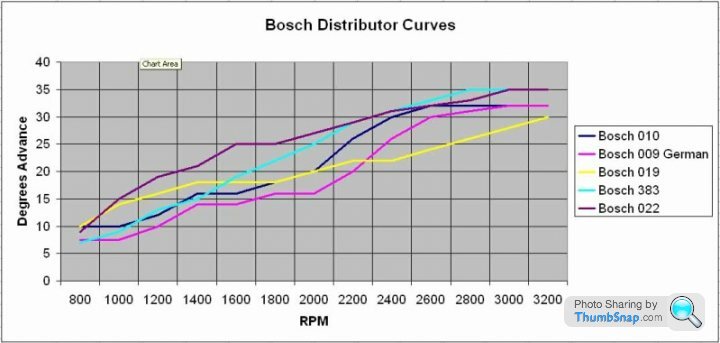
Above we can see some typical Bosch curves to demonstrate the very one dimensional linear way a distributor adds timing in response to increasing engine speed. The yellow line delivered by the Bosch 019, is by coincidence, very much like the curve delivered by the Lucas distributor fitted our our cars, but what we could actually do with is something a lot more like the blue line delivered by the Bosch 383 because as we can see it delivers 35 degrees of total timing instead of the 30 degrees served up by the Bosch 019.
Now compare these one dimensional distributor advance curves with my Canems 3D ignition map, the benefits are clearly revealed
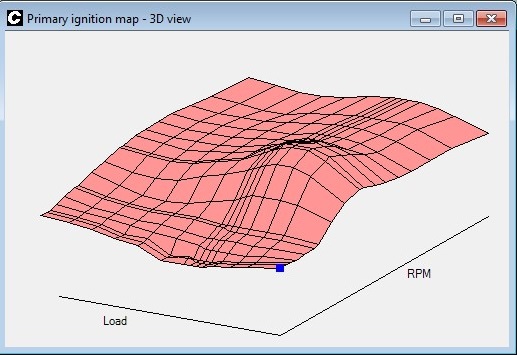
While we have now established the distributor is a rather crude and dumb device we should now consider the influence the vacuum advance unit has on the one dimensional linear mechanical advance curve, what people often don't realise is the vac advance unit is actually the closest thing to adaptive engine load referenced three dimensional ignition tuning. Anyone running a distributor should make no mistake, the vacuum advance unit is very much their friend, anyone who thinks disconnecting it is a good idea... needs to go back to school.
In the above example, and when accelerating to 3,250rpm, we have 10 degrees at idle + 18 degrees of mechanical advance plus maybe 3 degrees of vacuum advance if you're lucky, but in practice probably 0 degrees! Lets be generous and say 10 + 18 + 3 = 31 degrees which as we've already established is 5 degrees retarded from the optimal 36 degrees we would like when accelerating to 3,225rpm. But things get even worse if we are cruising at the same engine speed rather than accelerating because the engine is under far less load, so even though engine speed is the same we can get away with a leaner AFR to deliver better fuel economy. Leaner AFRs demand we ignite them earlier because lean mixtures take a little longer to burn, although it's really engine speed vs load that's of more influence when cruising on the motorway. When we are low load cruising like this the engine is also far less susceptible to detonation, this combined with the leaner AFRs we run means our 31 degrees is far from optimal... to be efficient we urgently need more timing.
A lot more timing
Enter stage left our old friend the vac advance unit, now we all know one of the key things that happens when we start cruising on the motorway is we naturally take our foot off the pedal, and miraculously the same road speed is maintained. The engine is now low load cruising, because we've closed the throttle but the engine (just a big vacuum pump) is still spinning fast at 3,250rpm its now sucking super hard against that almost closed throttle butterfly. The consequence of all this suck against that almost closed throttle butterfly is a huge rise in depression within the inlet manifold & plenum, so we use all this suck to pull on the vacuum advance unit which in turn adds roughly 10-12 degrees of timing as we cruise along at light load on our leaner and slower to burn AFR. What we end up with is not the total mechanical timing figure of 31 degrees under acceleration, but 28 degrees of mechanical timing plus 12 degrees of vacuum generated timing too.
So under cruise conditions we see... 10 idle + 18 additional mechanical at 3,250rpm = 28 degrees + 12 of additional vacuum derived timing = 40 degrees.
The truth is the poor old distributor on a Chimaera is all done adding mechanical advance by 2,800rpm, after that it doesn't have anything else to give which is a bit pants really. In addition the vac advance unit can only really help out to the tune of 12 degrees or so which is also pants because what you really want from the vac advance is 18 degrees to get you to the optimal cruising ignition timing figure of 46 degrees.
This is where the aftermarket ECU scores again because, as already stated, you can dial it whatever number is optimal without being held back by the constraints imposed by engine speed rules that govern a distributor, and the design limitations of the vac advance unit. While a distributor has clear limitations as does the vac advance unit, the two are very much designed to work together, if you disconnect your vac advance unit or make it work with ported vacuum instead of a nice strong and consistent full vacuum signal you will never get the best from what is already a compromised setup.
At this point I'll remind your of this, which hopefully is making even more sense to everyone now?

Remember, while engine speeds will change significantly, even the richest and leanest AFRs burn at a fairly fixed speed, at all times what we are trying to achieve irrespective engine speed is peak cylinder pressure at 15 degrees ATDC, so it stands to reason we need to light the fire earlier and earlier the faster the engine spins.
What we are trying to achieve when tuning the ignition timing is to start the combustion event at the right time so that maximum cylinder pressure occurs at approximately 15 degrees ATDC - This is called MBT timing which stands for Maximum Brake Torque timing, or Minimum timing for Best Torque.
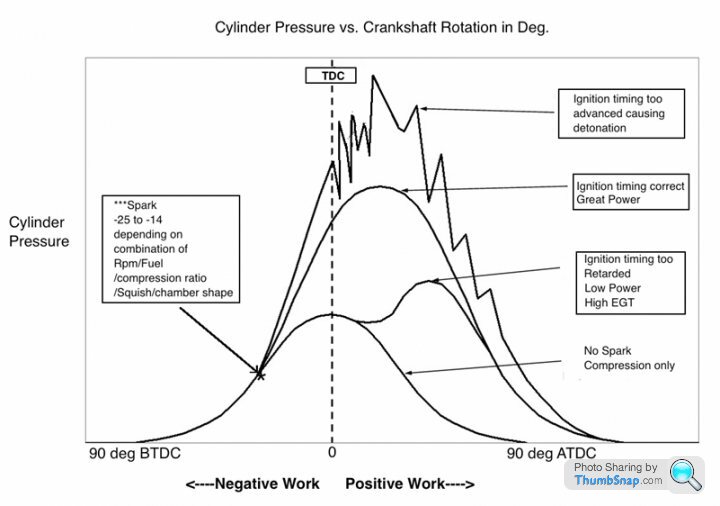
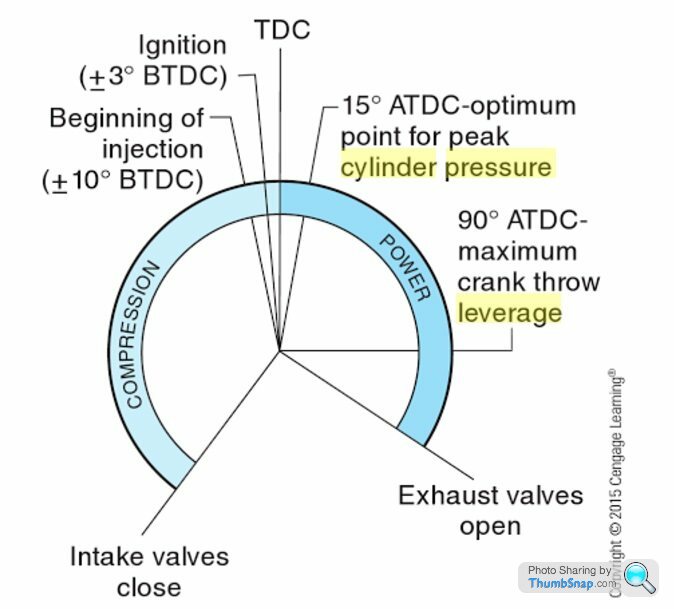
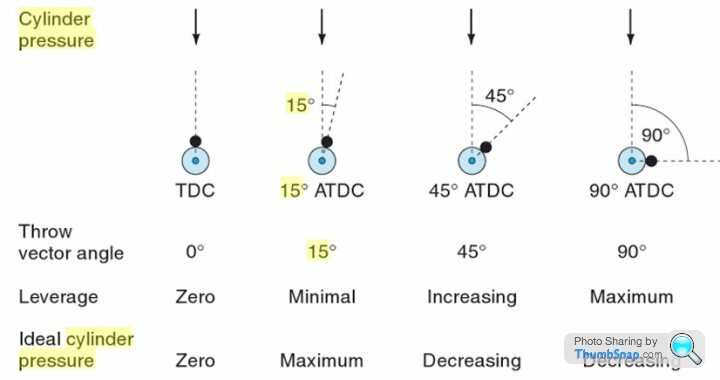
When you idle Old Rover at 1,000rpm and you light the fire ten degrees before the piston reaches top dead centre (BTDC), you will not achieve maximum cylinder pressure at 15 degrees after top dead centre (ATDC). What you need to do is light the fire earlier between 18-20 degrees before the piston reaches top dead centre, like this peak cylinder pressure will arrive at the magic 15 degrees ATDC just as we want.
This is why StuVT found more torque when he switched from the dreadful retarded timing strategy imposed by the standard emission driven ported vacuum arrangement, to applying a full vacuum signal to his vacuum advance unit to light the fire 12 degrees earlier (22 degrees before top dead centre)
Like this peak cylinder pressure arrives for StuVT at a much better 20 degrees ATDC rather than the highly inefficient 8 degrees imposed by Land Rover's 10 degrees idle timing number. StuVT should have not only found the extra torque he reports, but he should have heard a noticeable improvement in idle quality too. As already stated you can go too far when advancing timing, and now we know why, what StuVT needs to do now is retard his distributor by 2-4 degrees, like this he will find his peak cylinder pressure will now arrive around the optimal 15 degrees ATDC.
Be aware one or two degrees can make a big difference, so if StuVT doesn't have a rolling road to measure exactly where peak torque arrives, which is the same as proof of peak cylinder pressure arriving at 15 degrees ATDC, he needs to uses his ears to identify where the engine is happiest and his bum dyno to determine generally where the car drives best.
While both AFR and timing work hand in hand, the big improvements to be had really don't come from running a bit richer or leaner, they come from perfecting your ignition timing!
Easy innit
I’ve only just been looking at these tables from online vids If you are idling at 10 degrees with the vacuum advance disconnected, the maximum mechanical advance provided by the distributor when you increase engine speed to 3,250rpm is an additional 18 degrees,,,, so your peak timing number will be 10 + 18 = 28 degrees.
If you are idling at 10 degrees then connect the vacuum advance to full vacuum it will immediately add at least 10 degrees of timing, you are now idling at 10 + 10 = 20 degrees. But this does not mean your peak timing number will be 10 + 10 + 18 = 38 because one of those ten degree additions is coming from vacuum which does not exist to any meaningful degree when you are accelerating under load at wide open throttle.
What you're actually going to get under acceleration at 3,250rpm will be 10 degrees at idle + 18 degrees of mechanical advance plus maybe 3 degrees of vacuum advance if you're lucky!, so 10 + 18 + 3 = 31 degrees when what you really want is 36 degrees. This is a key area where a stand alone engine management system scores, because you can literally choose the optimal timing numbers irrespective of vacuum (load) or engine speed.
Distributors work well enough but they really aren't any more sophisticated than the governor on a steam engine, the faster a distributor spins the more advance you get, up to a limit. Just like a steam engine governor it also works on centrifugal force, the timing it adds can only ever be linear and in direct relation to engine speed, this is a problem as the timing an engine wants can sometimes be very different to the linear and one dimensional way a distributor behaves. A distributor advance curve can be changed easily enough by changing the bob weights and springs, but at the end of the day whatever you settle on will always be compromise, the curve is always going to be wrong in one area or another, indeed the truth is it will be wrong in a number of places.

Above we can see some typical Bosch curves to demonstrate the very one dimensional linear way a distributor adds timing in response to increasing engine speed. The yellow line delivered by the Bosch 019, is by coincidence, very much like the curve delivered by the Lucas distributor fitted our our cars, but what we could actually do with is something a lot more like the blue line delivered by the Bosch 383 because as we can see it delivers 35 degrees of total timing instead of the 30 degrees served up by the Bosch 019.
Now compare these one dimensional distributor advance curves with my Canems 3D ignition map, the benefits are clearly revealed


While we have now established the distributor is a rather crude and dumb device we should now consider the influence the vacuum advance unit has on the one dimensional linear mechanical advance curve, what people often don't realise is the vac advance unit is actually the closest thing to adaptive engine load referenced three dimensional ignition tuning. Anyone running a distributor should make no mistake, the vacuum advance unit is very much their friend, anyone who thinks disconnecting it is a good idea... needs to go back to school.
In the above example, and when accelerating to 3,250rpm, we have 10 degrees at idle + 18 degrees of mechanical advance plus maybe 3 degrees of vacuum advance if you're lucky, but in practice probably 0 degrees! Lets be generous and say 10 + 18 + 3 = 31 degrees which as we've already established is 5 degrees retarded from the optimal 36 degrees we would like when accelerating to 3,225rpm. But things get even worse if we are cruising at the same engine speed rather than accelerating because the engine is under far less load, so even though engine speed is the same we can get away with a leaner AFR to deliver better fuel economy. Leaner AFRs demand we ignite them earlier because lean mixtures take a little longer to burn, although it's really engine speed vs load that's of more influence when cruising on the motorway. When we are low load cruising like this the engine is also far less susceptible to detonation, this combined with the leaner AFRs we run means our 31 degrees is far from optimal... to be efficient we urgently need more timing.
A lot more timing

Enter stage left our old friend the vac advance unit, now we all know one of the key things that happens when we start cruising on the motorway is we naturally take our foot off the pedal, and miraculously the same road speed is maintained. The engine is now low load cruising, because we've closed the throttle but the engine (just a big vacuum pump) is still spinning fast at 3,250rpm its now sucking super hard against that almost closed throttle butterfly. The consequence of all this suck against that almost closed throttle butterfly is a huge rise in depression within the inlet manifold & plenum, so we use all this suck to pull on the vacuum advance unit which in turn adds roughly 10-12 degrees of timing as we cruise along at light load on our leaner and slower to burn AFR. What we end up with is not the total mechanical timing figure of 31 degrees under acceleration, but 28 degrees of mechanical timing plus 12 degrees of vacuum generated timing too.
So under cruise conditions we see... 10 idle + 18 additional mechanical at 3,250rpm = 28 degrees + 12 of additional vacuum derived timing = 40 degrees.
The truth is the poor old distributor on a Chimaera is all done adding mechanical advance by 2,800rpm, after that it doesn't have anything else to give which is a bit pants really. In addition the vac advance unit can only really help out to the tune of 12 degrees or so which is also pants because what you really want from the vac advance is 18 degrees to get you to the optimal cruising ignition timing figure of 46 degrees.
This is where the aftermarket ECU scores again because, as already stated, you can dial it whatever number is optimal without being held back by the constraints imposed by engine speed rules that govern a distributor, and the design limitations of the vac advance unit. While a distributor has clear limitations as does the vac advance unit, the two are very much designed to work together, if you disconnect your vac advance unit or make it work with ported vacuum instead of a nice strong and consistent full vacuum signal you will never get the best from what is already a compromised setup.
At this point I'll remind your of this, which hopefully is making even more sense to everyone now?

Remember, while engine speeds will change significantly, even the richest and leanest AFRs burn at a fairly fixed speed, at all times what we are trying to achieve irrespective engine speed is peak cylinder pressure at 15 degrees ATDC, so it stands to reason we need to light the fire earlier and earlier the faster the engine spins.
What we are trying to achieve when tuning the ignition timing is to start the combustion event at the right time so that maximum cylinder pressure occurs at approximately 15 degrees ATDC - This is called MBT timing which stands for Maximum Brake Torque timing, or Minimum timing for Best Torque.



When you idle Old Rover at 1,000rpm and you light the fire ten degrees before the piston reaches top dead centre (BTDC), you will not achieve maximum cylinder pressure at 15 degrees after top dead centre (ATDC). What you need to do is light the fire earlier between 18-20 degrees before the piston reaches top dead centre, like this peak cylinder pressure will arrive at the magic 15 degrees ATDC just as we want.
This is why StuVT found more torque when he switched from the dreadful retarded timing strategy imposed by the standard emission driven ported vacuum arrangement, to applying a full vacuum signal to his vacuum advance unit to light the fire 12 degrees earlier (22 degrees before top dead centre)
Like this peak cylinder pressure arrives for StuVT at a much better 20 degrees ATDC rather than the highly inefficient 8 degrees imposed by Land Rover's 10 degrees idle timing number. StuVT should have not only found the extra torque he reports, but he should have heard a noticeable improvement in idle quality too. As already stated you can go too far when advancing timing, and now we know why, what StuVT needs to do now is retard his distributor by 2-4 degrees, like this he will find his peak cylinder pressure will now arrive around the optimal 15 degrees ATDC.
Be aware one or two degrees can make a big difference, so if StuVT doesn't have a rolling road to measure exactly where peak torque arrives, which is the same as proof of peak cylinder pressure arriving at 15 degrees ATDC, he needs to uses his ears to identify where the engine is happiest and his bum dyno to determine generally where the car drives best.
While both AFR and timing work hand in hand, the big improvements to be had really don't come from running a bit richer or leaner, they come from perfecting your ignition timing!
Easy innit

Edited by ChimpOnGas on Saturday 10th February 08:51

Loving this work dude

I finally got out today and it was a bit odd actually looking for traffic.
Anyway I am a convert. After letting it warm up I found a steep hill near Whipsnade Zoo and couldn't detect any pinging, all noises were regular and I have a slight blow on a V clamp for the Y piece but that is a regular sound and is always there, but at 26 full mech advance I doubt pinging will be an issue. I need to make some new det cans. Mine were rather perished and not ear worthy.....
I cruised the town centre where I know traffic builds.
The car is definately calmer to drive like this. There is a hint of shunting but its only slight and after a while I didnt notice it. It would cruise at 30mph in 4th at idle and in 1st and 2nd I got the revs to between 1200 and 1800 and changed the throttle position to stimulate slow traffic. This is where the possible diluted shunt, like a slight hesitation manifests itself.
I'm considering moving the distributor to the 22btdc mark I made at idle to see if this cures the slight hesitation. But to be honest where it is now is fine. I cruised the town centre traffic for an hour and it was relaxed and I actually enjoyed it. Before it was like river dance in the clutch and throttle to keep it smooth.
I know its arctic out there but the temp was just under 90c the whole time.
On the open road it pulls from idle up to the limiter smoothly and goes like a stabbed rat!
Off the national speed limit roads back into the town traffic and it stayed just below 90c and continued to crawl in traffic rather civilised again.
The only issue thats unchanged is the shift from 1st to 2nd is jerky. It may be me or a thing they all do, but I hoped this was connected with shunting.
Overall, very happy with it. So much calmer to drive in town.
ChimpOnGas - Thank you for sharing your findings.
Im seriously considering having the distributor modded to mimic your ignition curves at some point this year if you would be happy to share.
Stu
Anyway I am a convert. After letting it warm up I found a steep hill near Whipsnade Zoo and couldn't detect any pinging, all noises were regular and I have a slight blow on a V clamp for the Y piece but that is a regular sound and is always there, but at 26 full mech advance I doubt pinging will be an issue. I need to make some new det cans. Mine were rather perished and not ear worthy.....
I cruised the town centre where I know traffic builds.
The car is definately calmer to drive like this. There is a hint of shunting but its only slight and after a while I didnt notice it. It would cruise at 30mph in 4th at idle and in 1st and 2nd I got the revs to between 1200 and 1800 and changed the throttle position to stimulate slow traffic. This is where the possible diluted shunt, like a slight hesitation manifests itself.
I'm considering moving the distributor to the 22btdc mark I made at idle to see if this cures the slight hesitation. But to be honest where it is now is fine. I cruised the town centre traffic for an hour and it was relaxed and I actually enjoyed it. Before it was like river dance in the clutch and throttle to keep it smooth.
I know its arctic out there but the temp was just under 90c the whole time.
On the open road it pulls from idle up to the limiter smoothly and goes like a stabbed rat!
Off the national speed limit roads back into the town traffic and it stayed just below 90c and continued to crawl in traffic rather civilised again.
The only issue thats unchanged is the shift from 1st to 2nd is jerky. It may be me or a thing they all do, but I hoped this was connected with shunting.
Overall, very happy with it. So much calmer to drive in town.
ChimpOnGas - Thank you for sharing your findings.
Im seriously considering having the distributor modded to mimic your ignition curves at some point this year if you would be happy to share.
Stu
Idle 8deg BTDC vac OFF which with
full vacuum the figure is 18deg BTDC. Vacuum taken from the plenum take off that was used by the fuel fume purge device.
This gives 26deg full mechanical advance at 3500rpm+ and around 36deg vac and mechanical for cruise.
Base idle set to 600rpm, which gave 950rpm with the bypass hose unclamped.
PcV fitted to the flame trap.
Fuel purge equipment removed.
All breather hoses jubilee clipped.
full vacuum the figure is 18deg BTDC. Vacuum taken from the plenum take off that was used by the fuel fume purge device.
This gives 26deg full mechanical advance at 3500rpm+ and around 36deg vac and mechanical for cruise.
Base idle set to 600rpm, which gave 950rpm with the bypass hose unclamped.
PcV fitted to the flame trap.
Fuel purge equipment removed.
All breather hoses jubilee clipped.
Great work Stuart, you've been very systematic in your testing and clear with your figures... this is exactly what was needed here.
It made me smile to see you using the phrase 'calmer to drive' a couple of times, as this is the same overriding first impression anyone who's just switched to a properly mapped aftermarket ECU will have, and was certainly my experience too. If you're any sort of a petrol head with an ear for these things (which you clearly are), the standard setup can't fail to make you feel anxious especially when driving through town.
Anxious to Calm in one easy and free to implement step, what's not to like
Your results also clearly demonstrate my point, which is that drivability is far greater influenced by ignition timing than it is by AFR or what we used to call mixture . For years people have fixated on the fueling side of these cars when all along this one simple and completely free ignition timing mod was staring them right in the face. You'd think if Mark Adams really was the RV8 tuning guru everyone said he was he'd have worked all this out years ago, clearly he never grew up around pre emissions 60's V8 running full vacuum to the vacuum advance unit
. For years people have fixated on the fueling side of these cars when all along this one simple and completely free ignition timing mod was staring them right in the face. You'd think if Mark Adams really was the RV8 tuning guru everyone said he was he'd have worked all this out years ago, clearly he never grew up around pre emissions 60's V8 running full vacuum to the vacuum advance unit 
The truth is now you've achieved your biggest gains by lighting that overly lean 14CUX fire a little earlier, you're now ready to catch the shunt at the other end by adding just a little more fuel, which is much more straightforward these days than it was even two years ago. Also consider a set of Denso TTs, the part number you'll want for the Rover V8 is IW20TT, it's £57 investment that really can do no harm:
http://www.ebay.co.uk/itm/8x-DENSO-IW20TT-IRIDIUM-...
Re the jerky 1st & 2nd change you describe as unchanged, I'm taking unchanged as no better but also no worse so in effect completely unchanged by your timing mods, as such and if it was me, I'd be thinking mechanical, IE diff bushes, throttle cable, throttle blade rest position ect ect;)
I'll leave you with one question that will help others decide if they should follow your lead of not...
Q: Now you've experienced the effects of full vacuum to your vac advance unit, will you be going back to the standard ported vacuum setup or leaving it as it is?
It made me smile to see you using the phrase 'calmer to drive' a couple of times, as this is the same overriding first impression anyone who's just switched to a properly mapped aftermarket ECU will have, and was certainly my experience too. If you're any sort of a petrol head with an ear for these things (which you clearly are), the standard setup can't fail to make you feel anxious especially when driving through town.
Anxious to Calm in one easy and free to implement step, what's not to like

Your results also clearly demonstrate my point, which is that drivability is far greater influenced by ignition timing than it is by AFR or what we used to call mixture
 . For years people have fixated on the fueling side of these cars when all along this one simple and completely free ignition timing mod was staring them right in the face. You'd think if Mark Adams really was the RV8 tuning guru everyone said he was he'd have worked all this out years ago, clearly he never grew up around pre emissions 60's V8 running full vacuum to the vacuum advance unit
. For years people have fixated on the fueling side of these cars when all along this one simple and completely free ignition timing mod was staring them right in the face. You'd think if Mark Adams really was the RV8 tuning guru everyone said he was he'd have worked all this out years ago, clearly he never grew up around pre emissions 60's V8 running full vacuum to the vacuum advance unit 
The truth is now you've achieved your biggest gains by lighting that overly lean 14CUX fire a little earlier, you're now ready to catch the shunt at the other end by adding just a little more fuel, which is much more straightforward these days than it was even two years ago. Also consider a set of Denso TTs, the part number you'll want for the Rover V8 is IW20TT, it's £57 investment that really can do no harm:
http://www.ebay.co.uk/itm/8x-DENSO-IW20TT-IRIDIUM-...
Re the jerky 1st & 2nd change you describe as unchanged, I'm taking unchanged as no better but also no worse so in effect completely unchanged by your timing mods, as such and if it was me, I'd be thinking mechanical, IE diff bushes, throttle cable, throttle blade rest position ect ect;)
I'll leave you with one question that will help others decide if they should follow your lead of not...
Q: Now you've experienced the effects of full vacuum to your vac advance unit, will you be going back to the standard ported vacuum setup or leaving it as it is?
I can answer your question easily
'No way Jose!!' Maybe for 1 hour a year for the MOT if its absolutely necessary when the main cat is back in.
You mentioned add more fuel? Isnt the fuelling locked on the cux? I will be getting some pintle injectors soon. Is it a case of upping the fuel pressure?
Jazz dude - The pcv is from Real Steel in Uxbridge. Its a GM style one part number BYFV184 £2.94 + vat. Fitted mine in the breather hose just as it comes off the fire trap on the rocker cover.
'No way Jose!!' Maybe for 1 hour a year for the MOT if its absolutely necessary when the main cat is back in.
You mentioned add more fuel? Isnt the fuelling locked on the cux? I will be getting some pintle injectors soon. Is it a case of upping the fuel pressure?
Jazz dude - The pcv is from Real Steel in Uxbridge. Its a GM style one part number BYFV184 £2.94 + vat. Fitted mine in the breather hose just as it comes off the fire trap on the rocker cover.
Edited by StuVT on Monday 26th February 20:26
The chrome bit goes into the rubber pipe just off of the fire trap. The pcv isnt a tight enough fit to go directly into the fire trap.
I then used a smaller diameter pipe onto the angled end to bulk it out and slid the original breather onto that and jubilee clipped everything tight.
I then used a smaller diameter pipe onto the angled end to bulk it out and slid the original breather onto that and jubilee clipped everything tight.
StuVT said:
I can answer your question easily.... 'No way Jose!!'
Maybe for 1 hour a year for the MOT if its absolutely necessary when the main cat is back in.
Maybe for 1 hour a year for the MOT if its absolutely necessary when the main cat is back in.
 , Thought you might say that, people should be thanking you more for the testing you've done, I at least expect to see some feedback from others who choose to follow your lead.
, Thought you might say that, people should be thanking you more for the testing you've done, I at least expect to see some feedback from others who choose to follow your lead.StuVT said:
You mentioned add more fuel? Isn't the fueling locked on the cux?
Yes would have been the answer a few years back, but these days you can burn yourself a richer chip, I'll step out at this point as others are better qualified to help. Just remember your ignition timing changes are likely to represent 95% of the improvement, a splash more fuel is really the 5% cherry on the cake, this is a point that seems to be completely lost on the 14CUX tweakers who foolishly start to believe they can solve anything with the Rover Gauge software and laptop 
StuVT said:
I will be getting some pintle injectors soon. Is it a case of upping the fuel pressure?
 )
)https://www.pistonheads.com/gassing/topic.asp?t=11...
And here I am sharing the specs on these injectors when I was Chimpandtonic (another stupid name)
https://www.pistonheads.com/gassing/topic.asp?t=11...
Going back to the vac advance thing, did you know the Lucas distributor fitted to our cars was originally designed to run vacuum retard and advance? Take a close look at your vac advance unit and you should see a takeoff in each side of the diaphragm, here's what I mean...
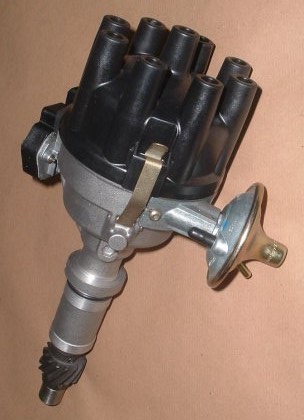
This is another stupid emissions strategy, it's basically a further enhancement of the dreaded ported vacuum idea, fortunately this was only ever inflicted on the Yanks. It all started with the US Export Triumph TR6 back in the late sixties, ironically while it did help a little bit with emissions it made throttle response terrible and also meant you burnt about 10% more fuel, but the dumb ass Americans didn't care about that because petrol (gas) to them has always been cheap as chips.
Here's how this nasty idea works, now you understand ported vacuum you should easily get the idea, just imagine how the vacuum switches from retard to advance and back again as the throttle butterfly is opened and closed.
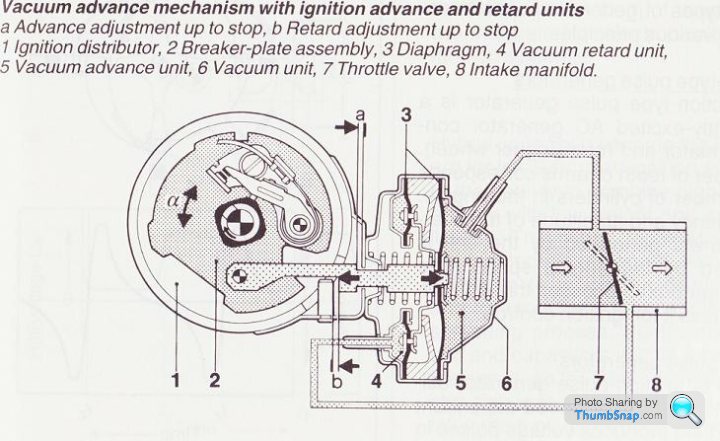
I mention the above for information purposes only, and to reinforce my ultimate point in all this which is...
All these emissions based bolt on strategies are always bad for drivability, fuel economy and performance

Edited by ChimpOnGas on Monday 26th February 21:29
StuVT said:
The chrome bit goes into the rubber pipe just off of the fire trap. The pcv isnt a tight enough fit to go directly into the fire trap.
I then used a smaller diameter pipe onto the angled end to bulk it out and slid the original breather onto that and jubilee clipped everything tight.
OK, I see so you fitted it in the straight bit of hose between the J bend near the flame trap and the t piece. I then used a smaller diameter pipe onto the angled end to bulk it out and slid the original breather onto that and jubilee clipped everything tight.
Presumably, you cut off the right angled part of the PCV valve to keep the breather hose in a straight line?
StuVT said:
No. I left the pcv uncut. Insted of the bend in the pipe off the flame trap leading the pipe across the engine I cut the bend out and used the pcv to acheive the same angle.
Thanks 
Will hopefully be finishing putting my ignition system back together this weekend so will be setting up my timing as per this thread.
One small question, when setting the timing without the vacuum pipe connected, should the end of the disconnected vacuum pipe be temporarily sealed or does that not make a difference ?
jazzdude said:
One small question, when setting the timing without the vacuum pipe connected, should the end of the disconnected vacuum pipe be temporarily sealed or does that not make a difference ?
The detailed answer is... if you're still on ported vacuum it won't make a blind bit of difference, there's such little suck (if any) at idle it will neither be a vacuum leak or have enough power to act on the vac advance unit... after all that's the fundamental concept behind ported vacuum.If however you're switching to full vacuum, not blocking the little hose you've pulled off the vac advance unit quite simply creates a vacuum leak down that hose. All be it a small one because the vac advance hose is of a rather small diameter, but it will be a vacuum leak all the same... and all vacuum leaks are bad!
So the simple answer is of course to block it!
Gassing Station | Chimaera | Top of Page | What's New | My Stuff






